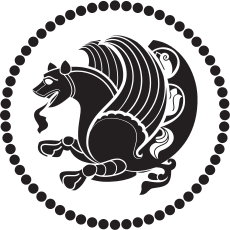List of shahanshahs of the Sasanian Empire
The Shahanshahs of the Sasanian Empire (Middle Persian: Šāhān šāh ī Ērān ud Anērān, "King of Kings of Iranians and non-Iranians") ruled over a vast territory. At its height, the empire spanned from Turkey and Rhodes in the west to Pakistan in the east, and also included territory in contemporary Caucasus, Yemen, UAE, Oman, Egypt, Israel, Lebanon, Syria, Jordan and Central Asia.
| "King of Kings of Iranians and non-Iranians" of the Sasanian Empire | |
|---|---|
| Šāhān šāh ī Ērān ud Anērān (Middle Persian) | |
Imperial | |
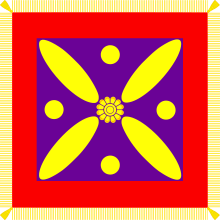 | |
| Details | |
| First monarch | Ardashir I (224–242) |
| Last monarch | Yazdegerd III (632–651) |
| Residence |
|
The Sasanian Empire was recognized as one of the main powers in the world alongside its neighboring arch rival, the Roman-Byzantine Empire, for a period of more than 400 years.[1][2][3][4] The Sasanian dynasty began with Ardashir I in 224, who was a Persian from Istakhr, and ended with Yazdegerd III in 651.[5]
The period from 631 (when Boran died) to 632 (when Yazdgerd III takes the throne) is confusing in determining proper succession because a number of rulers who took the throne were later removed or challenged by other members of the House of Sasan. The period was one of factionalism and division within the Sasanian Empire.[6]
Title
Ardashir I (r. 224–242), the founder of the Sassanian Empire, introduced the title "Shahanshah of the Iranians" (Middle Persian: šāhān šāh ī ērān; Parthian: šāhān šāh ī aryān). Ardashir's immediate successor, Shapur I (r. 240/42–270/72) chooses the titles in a precise manner in the inscription at Ka'ba-ye Zartosht. In that Shapur names four of his Sasanian predecessors with different titles and in "an ascending order of importance" by giving the title (Xwaday) "the lord" to Sasan, "the king" to Papag, "King of Kings of Iranians" to Ardashir, and "king of kings of Iranians and non-Iranians" (Middle Persian: MLKAn MLKA 'yr'n W 'nyr'n šāhān šāh ī ērān ud anērān;; Ancient Greek: βασιλεύς βασιλέων Αριανών basileús basiléōn Arianṓn) to himself.[7] The title "King of Kings of Iranians and non-Iranians" has also seen on a single silver coin of Shapur I, which indicates that the title was introduced after his victory over Romans and incorporation of non-Iranian lands into the Sassanian realms. The title was later used in coins of all later Sassanian kings.[8]
The Shahanshah
The head of the Sasanian Empire was the [shahanshah] (king of kings), also simply known as the shah (king). His health and welfare were always important and the phrase “May you be immortal" was used to reply to him with. By looking on the Sasanian coins which appeared from the 6th-century and afterward, a moon and sun are noticeable. The meaning of the moon and sun, in the words of the Iranian historian [Touraj Daryaee], “suggest that the king was at the center of the world and the sun and moon revolved around him. In effect, he was the “king of the four corners of the world," which was an old Mesopotamian idea."[9] The king saw all other rulers, such as the Romans, Turks, and Chinese, as being beneath him. The king wore colorful clothes, makeup, a heavy crown, while his beard was decorated with gold. The early Sasanian kings considered themselves of divine descent; they called themselves for “bay" (divine).[10]
When the king went to the publicity, he was hidden behind a curtain,[9] and had some of his men in front of him, whose duty was to keep the masses away from the king and to make his way clear.[11] When one came to the king, he/she had to prostrate before him, also known as proskynesis. The king was guarded by a group of royal guards, known as the pushtigban. On other occasions, the king was protected by a group of palace guards, known as the darigan. Both of these groups were enlisted from royal families of the Sasanian Empire,[11] and were under the command of the hazarbed, who was in charge of the king's safety, controlled the entrance of the kings palace, presented visitors to the king, and was allowed to be given military command or used in negotiations. The hazarbed was also allowed in some cases to serve as the royal executioner.[11] During Nowruz (Iranian new year) and Mihragan (Mihr's day), the king would hold a speech.[10]
Sasanian state organization
Throughout its existence, the Sassanid Empire was an absolute monarchy. The Shahenshah was the height of authority, with satraps ruling over their satrapies underneath them. The shahanshah was the highest form of authority throughout the empire, but often faced rebellions from their satraps. In fact, the Sasanian Empire had been founded when a satrap rebelled against the Parthian Empire.[12]
The Sasanian Empire reached its greatest extent under Khosrow II, who reigned for 38 years; the longest reigning king was Shapur II, who reigned for 70 years.
The Sasanian kings regarded themselves as successors of the Achaemenid Empire, and many Sasanian kings' goal was to conquer all territory previously held by the Achaemenids.
List of shahanshahs
The table below lists Sasanian shahanshahs and titles used by them.
Titles used by the Sasanian shahanshahs was:
| # | Shahanshah | Coin or statue | Reigned from | Reigned until | Relationship to Predecessor | Notes | |||
|---|---|---|---|---|---|---|---|---|---|
| House of Sasan | |||||||||
| 1 | Ardashir I |  |
224 | February 242 | — |
| |||
| 2 | Shapur I | 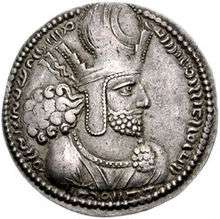 |
12 April 240 | May 270 | Son |
| |||
| 3 | Hormizd I |  |
May 270 | June 271 | Son |
| |||
| 4 | Bahram I | .jpg) |
June 271 | September 274 | Brother |
| |||
| 5 | Bahram II | .jpg) |
274 | 293 | Son |
| |||
| 6 | Bahram III |  |
293 | 293 | Son |
| |||
| 7 | Narseh |  |
293 | 302 | Grand-uncle |
| |||
| 8 | Hormizd II | .jpg) |
302 | 309 | Son |
| |||
| 9 | Adur Narseh |  |
309 | 309 | Son |
| |||
| 10 | Shapur II | 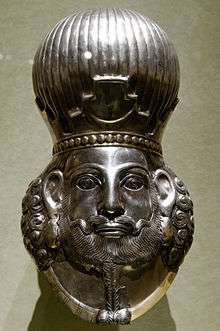 |
309 | 379 | Brother |
| |||
| 11 | Ardashir II | 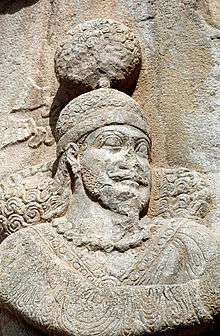 |
379 | 383 | Brother |
| |||
| 12 | Shapur III |  |
383 | 388 | Nephew | ||||
| 13 | Bahram IV | %2C_Herat_mint.jpg) |
388 | 399 | Son | ||||
| 14 | Yazdegerd I | 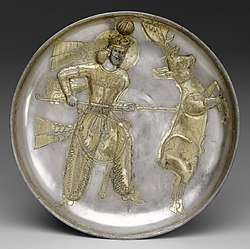 |
399 | 420 | Brother | ||||
| 15 | Shapur IV |  |
420 | 420 | Son | ||||
| 16 | Khosrow |  |
420 | 420 | Cousin | ||||
| 17 | Bahram V | 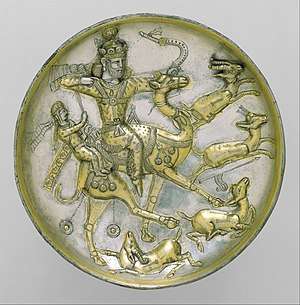 |
420 | 438 | Cousin | ||||
| 18 | Yazdegerd II | 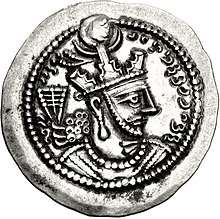 |
438 | 457 | Son | ||||
| 19 | Hormizd III | 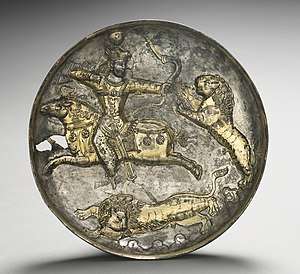 |
457 | 459 | Son | ||||
| 20 | Peroz I | 457 | 484 | Brother | |||||
| 21 | Balash | 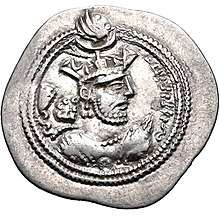 |
484 | 488 | Brother |
| |||
| 22 | Kavad I | .jpg) |
488 | 496 | Nephew |
| |||
| 23 | Jamasp | 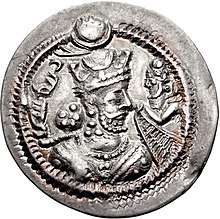 |
496 | 498 | Brother | ||||
| 24 | Kavad I | .jpg) |
498 | 531 | Brother |
| |||
| 25 | Khosrow I |  |
531 | 579 | Son | ||||
| 26 | Hormizd IV | 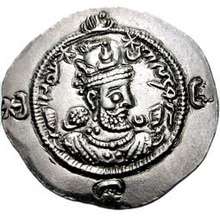 |
579 | 590 | Son | ||||
| 27 | Khosrow II |  |
590 | 590 | Son |
| |||
| House of Mihran | |||||||||
| 28 | Bahram VI Chobin | 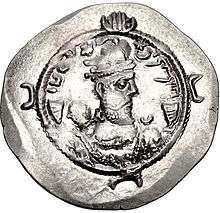 |
590 | 591 | Rebel |
| |||
| House of Sasan | |||||||||
| 29 | Khosrow II |  |
591 | 628 | Son of Hormizd IV |
| |||
| House of Ispahbudhan | |||||||||
| 30 | Vistahm | 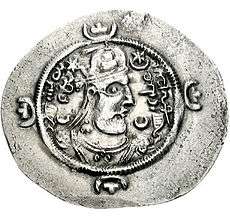 |
591 | 595 | Uncle |
| |||
| House of Sasan | |||||||||
| 31 | Kavad II | %2C_minted_at_Ray_in_628.jpg) |
628 | 628 | Greatnephew |
| |||
| 32 | Ardashir III |  |
628 | 630 | Son | ||||
| House of Mihran | |||||||||
| 33 | Shahrbaraz |  |
27 April 630 | 17 June 630 | General |
| |||
| House of Sasan | |||||||||
| 34 | Khosrow III | 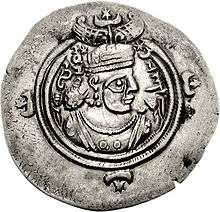 |
630 | 630 | Nephew of Khosrow II | Briefly ruled in Khorasan as rival king | |||
| 35 | Boran | 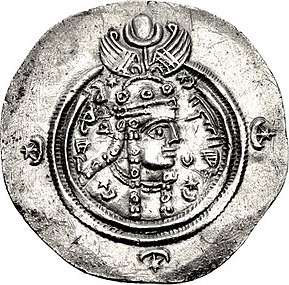 |
630 | 630 | Daughter of Khosrow II |
| |||
| 36 | Shapur-i Shahrvaraz |  |
630 | 630 | Son of Shahrbaraz and a sister of Khosrow II | ||||
| 37 | Peroz II |  |
630 | 630 | Descended from Khosrow I | ||||
| 38 | Azarmidokht | 630 | 631 | Daughter of Khosrow II |
| ||||
| House of Ispahbudhan | |||||||||
| 39 | Farrukh Hormizd |  |
630 | 631 | General | ||||
| House of Sasan | |||||||||
| 40 | Hormizd VI |  |
630 | 632 | Usurper | ||||
| 41 | Khosrow IV |  |
630 | 636 | Brother of Peroz II | ||||
| 42 | Farrukhzad Khosrow V | March 631 | April 631 | Son of Khosrow II | |||||
| 43 | Boran |  |
June 631 | June 632 | Daughter of Khosrow II |
| |||
| 44 | Yazdegerd III | 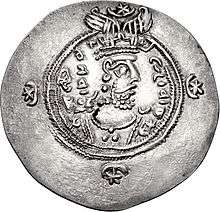 |
June 632 | 651 | Grandson of Khosrau II |
| |||
| Destruction of the Sassanid Empire | |||||||||
| - | Peroz III |  |
651 (In exile) | 679 (In exile) | Son |
| |||
| - | Narsieh (Narseh II) |  |
679 (In exile) | Unknown | Son |
| |||
| - | Bahram VII |  |
Unknown | 710 (in exile) | Son of Yazdegerd III | ||||
| - | Khosrau VI |  |
Unknown | Unknown | Unknown |
| |||
See also
References
- "The Cambridge Illustrated History of the Islamic World" (PDF). Archived from the original (PDF) on 14 July 2014. Retrieved 6 June 2014.
- Shapur Shahbazi, A. (2005), "Sasanian Dynasty", Encyclopedia Iranica, Columbia University Press, 1
- Norman A. Stillman The Jews of Arab Lands pp 22 Jewish Publication Society, 1979 ISBN 0827611552
- International Congress of Byzantine Studies Proceedings of the 21st International Congress of Byzantine Studies, London, 21–26 August 2006, Volumes 1-3 pp 29. Ashgate Pub Co, 30 sep. 2006 ISBN 075465740X
- Daryaee 2012, p. 392.
- Daryaee 2012, p. 201.
- Frye, R. N. (1983). "Chapter 4: The political history of Iran under the Sasanians". The Cambridge History of Iran. 3. Cambridge University Press. p. 116. ISBN 978-0-521-20092-9.
- "A Unique Drachm Coin of Shapur I". Iranian Studies. 50: 331–344. doi:10.1080/00210862.2017.1303329.
- Daryaee 2008, p. 41.
- Daryaee 2008, p. 42.
- Morony 2005, p. 92.
- Freedman 2000, p. 458.
Sources
- Daryaee, Touraj (2008). Sasanian Persia: The Rise and Fall of an Empire. I.B.Tauris. pp. 1–240. ISBN 0857716662.CS1 maint: ref=harv (link)
- Daryaee, Touraj (2012). The Oxford handbook of Iranian history. Oxford: Oxford University Press. ISBN 9780199732159. OCLC 670375356.CS1 maint: ref=harv (link)
- Molavi, Afshin (2002), Persian pilgrimages: journeys across Iran (Illustrated ed.), W. W. Norton & Company, ISBN 0-393-05119-6, retrieved 17 January 2010
- Freedman, David Noel (2000), Michael J. McClymond (ed.), The Rivers of Paradise: Moses, Buddha, Confucius, Jesus, and Muhammad As Religious Founders, Wm. B. Eerdmans Publishing, ISBN 0-8028-2957-0
